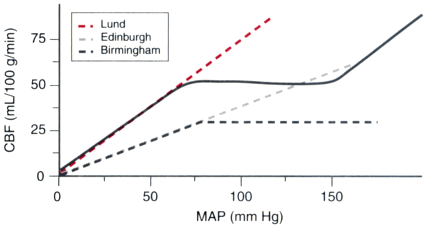 |
 |
Figure 53-16
Relationship of cerebral blood flow (CBF) to blood pressure
after head injury. There are three cerebral perfusion pressure (CPP) management
strategies (see text) driven by differing beliefs about common pathophysiologic derangements.
The most commonly held, the "Edinburgh" (so named for the institution of the original
proponents), emphasizes low postinjury CBF, impaired autoregulation, and the necessity
to support CPP (mean arterial pressure [MAP] — intracranial pressure [ICP])
to 70 mm Hg. The "Lund concept" emphasizes the contribution of hyperemia to the
occurrence of elevated ICP. That approach uses antihypertensive agents to reduce
blood pressure while maintaining CPP over 50 mm Hg.[277]
That CPP target has increased, in the most recent iteration to 60 to 70 mm Hg with
allowance for occasional reduction to 50.[278]
An approach emanating from the University of Alabama, identified as the "Birmingham"
concept, entails pharmacologically induced hypertension. This approach is based
on the belief that autoregulation is largely intact and that hypertension will result
in cerebral vasoconstriction with concomitantly reduced CBV and ICP.[279]
[280]

 |
